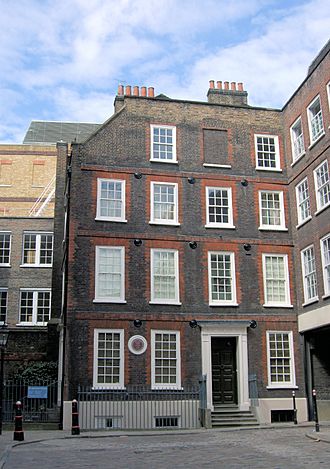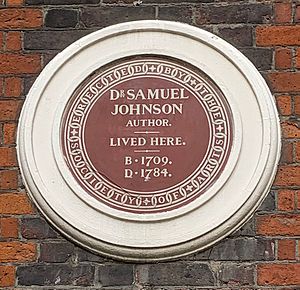Dr Johnson's House facts for kids
Quick facts for kids Dr Johnson's House |
|
|---|---|

Dr Johnson's House seen from Gough Square, in 2010
|
|
| General information | |
| Town or city | City of London London, EC4A |
| Country | England, United Kingdom |
| Completed | c. 1700 |
| Renovated | 1914 |
| Client | Richard Gough |
| Technical details | |
| Floor count | 5 |
| Designations | Grade I listed |
| Known for | Home of Samuel Johnson from 1748 to 1759 |
Dr Johnson's House is a special museum in London. It was once the home of Samuel Johnson, a famous English writer from the 1700s. He was also a lexicographer, which means he wrote dictionaries. This house is very old and important, so it is called a Grade I listed building.
Contents
What is Dr Johnson's House?
A Glimpse into History
This house was built around 1700 by a wool merchant named Richard Gough. It is one of the few old houses from that time still standing in the City of London. Samuel Johnson lived in many places in the city, but this is the only one that remains.
The house is located at 17 Gough Square. This is a small, L-shaped area with old alleyways near Fleet Street. It has four wide sections and is five stories tall.
Samuel Johnson's Time Here
Samuel Johnson lived and worked in this house from 1748 to 1759. He paid £30 in rent each year. This was where he created his very famous book, A Dictionary of the English Language. Imagine writing a whole dictionary in one house!
After Johnson left, the house was used for different things. In the 1800s, it was a hotel, a print shop, and even a storage building.
Saving a Piece of History
In 1911, a newspaper owner and politician named Cecil Harmsworth bought the house. He said it looked very old and run-down. He wanted to save it.
Mr. Harmsworth worked with an architect named Alfred Burr to fix up the house. They restored it carefully. In 1914, the house opened to the public as a museum. Today, a charity called Dr Johnson's House Trust Ltd. takes care of it.
What You Can See Inside
Inside Dr Johnson's House, you can see rooms with wooden panels. There is also a beautiful pine staircase. The house has a collection of old furniture, pictures, and portraits from Johnson's time.
There are also exhibits that teach you about Samuel Johnson's life and his work. Outside the house, you can see a special commemorative plaque. It was put there in 1898 by the Royal Society of Arts to remember Johnson.
See Also
- Samuel Johnson Birthplace Museum in Lichfield
- Hodge (cat)


